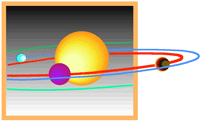
How Does Life Begin and Develop?
Goal
1
How
Life Arose on Earth
Goal
2
Organization of Matter into Living Systems
Goal
4
Coevolution of the Biosphere and the Earth
Does Life Exist Elsewhere in the Universe?
Goal
7
Signature of Life on Other Worlds
Goal
8
Life on Mars and Europa
What is Life's Future on Earth and Beyond?
Goal
9
Environmental Change on Earth
Goal
10
Terrestrial Life in Space
Question: Does Life Exist Elsewhere in the Universe?
Goal
6: Determine What Makes a Planet Habitable and How Common These Worlds
Are in the Universe
 Investigate how planets
acquire and sustain liquid water, and use theoretical and observational
studies of the processes of planet formation as well as surveys of a representative
sample of planetary systems to locate possible abodes for life.
Investigate how planets
acquire and sustain liquid water, and use theoretical and observational
studies of the processes of planet formation as well as surveys of a representative
sample of planetary systems to locate possible abodes for life.
Where should we look for extraterrestrial life? Based on our only example (life on Earth), liquid water is a requirement. We must therefore determine what sort of planets are likely to have liquid water and how common they might be. Understanding the origin of water on our own planet and other member of the solar system will yield insights on the ways water might be distributed within an emerging planetary system, and research on climate changes in response to solar variability will investigate the long-term stability of habitability on a planet. Studying the processes of planet formation and surveying a representative sample of planetary systems will determine what planets are present and how they are distributed, essential knowledge for judging the frequency of habitable planets.
Background
The abundance of planets with habitable environments is critical for understanding the role of life in the universe. The formation of planets, and the resulting configuration of planetary systems, can be approached both empirically and theoretically. In order to understand fully the process of planet formation, especially as it relates to planetary habitability, our current observational data base must be expanded to include higher spatial and spectral resolution studies of protoplanetary disks, detection and study of extra-solar planetary systems (down to and including Earth-sized planets), and distribution and properties of small bodies and dust in the solar system. From our only known example of life, we conclude that habitability depends on the existence and long term stability of liquid water in which nutrient and waste transport can occur and catalytic function and exchange of genetic material are possible. There must also be a source of energy that maintains the system away from the equilibrium state. Since all life with which we are familiar requires liquid water during at least some stage of its life cycle, the criteria for habitability should begin with the need for liquid water. Even with this limitation, there are many questions to be answered in order to understand where life might originate and thrive. Was Earth's water included in the original planetesimals from which Earth formed, or added later by impacts of asteroids or comets? Given the changes in the Sun's brightness over the past 4.5 billion years, how was water maintained as a liquid throughout most of Earth's history? As a starting point, the habitable zone in any planetary system is most simply defined as the region where liquid water is stable on a planet's surface, which depends on the type of star and the planet's orbit (and may even be possible on a satellite around another planet). The frequency of occurrence of planets in habitable regions around other stars must be answered empirically, by surveying a representative sample of planetary systems (including Earth-mass planets) and determining their configuration. Understanding the stability of climate is related to Goal 4, while establishing the limits of habitability relates directly to Goal 5 and Goal 8.